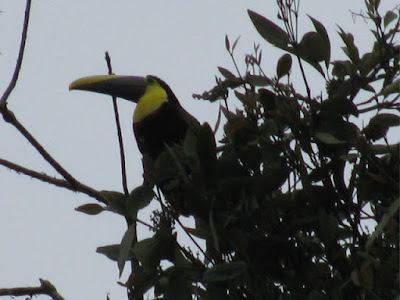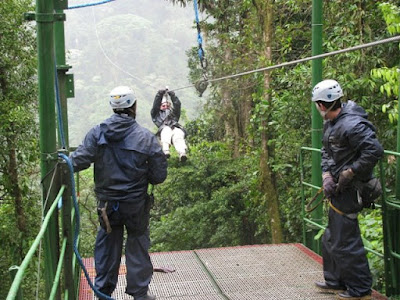I just returned from 3 wonderful weeks in Costa Rica. I will narrate my trip and then pictures will be at the end, not necessarily in the order they were taken.
Just getting there was an adventure. We were supposed to fly out of Phoenix to Dallas-Ft. Worth, and transfer to our flight to San Jose, Costa Rica. But our flight out of Phoenix was late, we missed our connection in Dallas-Ft. Worth, they only fly out of Dallas-Ft. Worth to Costa Rica 3 times a week, so they rerouted us to Miami. We arrived in Miami about the time we were to arrive in San Jose. The airlines gave us a voucher for a hotel, but we only had about 4 hours before getting up to catch our new flight to San Jose. All in all, we arrived only 12 hours behind schedule. Not too bad.
We immediately went roaming the downtown area of San Jose after arriving at our hotel. We were only about 5 blocks from the main section of downtown. Our hotel was once a private home which has now been turned into a small hotel. This area of town was once the main residential area of the rich and influential people of San Jose. But like all urban areas, the newer more affluent housing is now moved out of town.
While in San Jose we saw the National Museum, many old, historical buildings including a cathedral and many sculptures. San Jose was a pretty town. In fact, I found Costa Rica to be a very clean country. There were the slums, like all places, but overall I found people kept the areas very clean and well kept.
We only had 2 nights in San Jose before moving on.
Next stop was Tortuguero National Park. It is famous for its nesting grounds for the green sea turtle. On the way we passed through Braulio Carrillo National Park and saw a Dole Banana plantation. The only way to get to Tortuguero is via boat. The entire park is surrounded by water. It is a rain forest and swamp, next to the Atlantic Ocean, but some years ago, before it was a National Park, the logging companies dredged canals. We arrived an Cano Blanco to catch our 1 1/2 hour boat ride to the lodge. There are no roads at all in the area.
Right outside our cabin were several Howler Monkeys to greet us. They say you can hear them holler for 2 miles and I believe that. We had several boat trips through the canals to see the local wildlife. We saw many birds, 3 types of monkeys, a sloth and caimans. There are also crocodiles, but we didn't see any. There was entertainment for us every evening and we had a pool to relax in when we weren't out in the boats. We also took a water taxi across the river to the village and walked along the Atlantic Ocean on the Caribbean side of Costa Rica.
After 3 nights here we took the boat back to Cano Blanco where we took a bus to Guipels, had lunch and caught our transfer ride to Arenal.
Arenal Volcano was inactive until 1968, when without warning it erupted and destroyed 2 villages and killed over 30 people. Since then it has continued to be active with major eruptions again in the 1970s and in 1992. It is now closely watched by both scientists and tourists. We spent 5 nights at a hotel with a magnificent view of the volcano. Because we were there multiple days we got to see the volcano unclouded. Many people never get to see the top of the volcano because it is usually enveloped in clouds and steam.
While in Arenal we took our first zip line tour. Sky Trek is reputed to be the most "thrilling" zip line in Costa Rica. They have 8 zip lines, the highest which is over 600 ft., and the longest almost 1/2 mile. It was raining so we didn't get to see the rain forest much because of the clouds, but it was still lots of fun. We also walked to La Fortuna, about 7 km, which is the nearest town. Another day we walked the other direction to Tabacon Resort, the most famous hot spring resort in the area (and also the most expensive). Another day we took off again on a hike and found a dirt road leading back to a new resort. Along the way we saw a toucan. Yes, the Fruit Loops cereal bird. But even our hotel had its own hot springs. There were 11 tiered hot springs, each one slightly different temp from the others. But even the swim up bar was a mineral hot spring. Our last tour of Arenal was the National Park. While hiking there we could hear the volcano erupting almost continuously. At the closest point they allow visitors, which is still almost 5 km away, you could see the lava and boulders spewing and rolling downhill.
A note about the food. The first day we arrived, we stopped at a restaurant and noticed they had daily specials they called a 'typical mean'. We found they had these everywhere we went. A Costa Rican typical mean always consisted of rice and black beans, a choice of meat (which could be beef, chicken or fish), usually some salad and fried plantains. Some places even included a drink which was always fruit juice. The country drinks lots of fruit juices, almost always fresh.
Next we were on our way to Monteverde. This area was originally settled by Quakers in the 1940s and 1950s. Now it is booming in coffee plantations, but mostly tourism of the multiple cloud forest preserves in the area. We took a van to the boat which took us across Lake Arenal. Then another van took us to Santa Elena where we stayed. The roads in Costa Rica are primitive. Many roads you would not want to attempt without at least a high clearance vehicle, and many need 4 wheel drive. They are all bumpy, have holes and as many of the drivers tell you, "You get a free massage on this trip".
We visited Monteverde Cloud Forest Preserve, Selvatura Hanging Bridges, and the Monteverde Coffee Co-op while in the area. It also rained and we were stuck in our hotel for 2 days while it poured. We saw lots of birds and wildlife, including the elusive and endangered Quetzal bird. The Quetzal is the bird of the Aztecs and its feathers were prized by the natives for use in making ornaments. There are supposed to only be about 100 pairs left in the world. We saw 2 males and a female. Beautiful birds.
I also found out what 'shade grown coffee' means. Instead of a farmer planting row upon row of coffee, some plant their coffee in amongst other plants such as plantains and fruit trees and vegetables. This is considered shade grown coffee. It is usually organically grown as well. Also you have 'sun dried coffee'. In normal coffee production the coffee bean is removed from the fruit before being dried and processed. In sun dried coffee they allow the coffee fruit to dry naturally before extracting the bean. This makes for a much more flavorful and less bitter coffee. I tried some which the coffee farm owner had grown, dried and roasted himself. It was wonderful coffee.
Our next and last stop was to the Pacific Ocean, specifically, Flamingo Beach or Playa Flamingo. It was warm, in the 90s, and sunny. We got up and went swimming in the ocean every morning, then came back and swam in the pool before heading out for activities for the day. Here we ate fresh fish, took an ATV trip, another zip line trip and lots of sight seeing.
I would recommend Costa Rica to anyone and I would definitely go back because there are so many places I did not get to see.
 |
| Zip lining outside of Playa Flamingo. Not as high as the previous zip lines, nor as long, but we sure did have fun. |
 |
| Here is a shot of the 1/2 mile long zip line outside of Arenal. |
 |
| This bird is a Montezuma and build long hanging nests. They look like large fruits hanging from the trees. They are quite common in Costa Rica. |
 |
| Even in San Jose we found a Walmart Greeter. Actually there were no other employees with this tag and no name on the store, so I don't really know if it was a Walmart or not. |
 |
| At the Britannia Hotel in San Jose waiting for our van to pick us up for our trip to Pachira Lodge. |

































4 comments:
Terrific post! Great narration and pictures. I wanna go. Pretty impressive limbo too.
Love your pictures. Makes me want to go there. What a Limbo shot!
When are you going to host a Win trip there?
Wow, that looks like the trip of a lifetime! Thanks for sharing.
Post a Comment